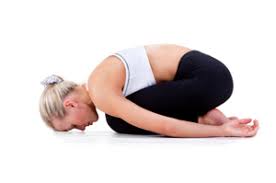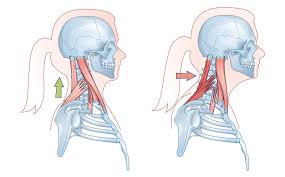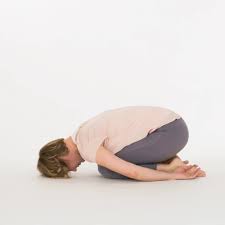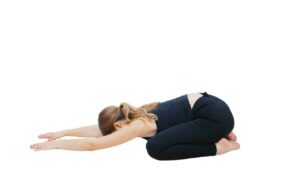

Learning how to fix nerd neck with child’s pose is not as tough as you might be thinking.
If you suffer from nerd neck and are looking the best forward head posture fix then, yoga definitely comes to your rescue.
As per bestforwardheadposturefix.com, “With 90% of the world’s population using cellphones, crane neck posture is simply inevitable”.
Forward head can strike at will and shall not spare you of its deadly wrath.
Most people with text neck tend to “live with it”. They falsely consider a vulture neck posture to be a “part and parcel” of their tech-savvy lifestyle.
Not only does a bad neck posture ruin your cervical spine, it also adversely impacts your mental health.
So, seek a cure and get pull your head up before it is too late.
One such way to do so is by mastering child’s pose. Here is how you do it:
Contents of “How to Fix Nerd Neck with Child’s Pose” Article:
1) Why are Millions across the Globe Suffering from Forward Head Posture?
- The Screen-Centric Lifestyle
- Sedentary Living and Muscle Imbalance
- Stress and the Subconscious Hunch
- Conclusion
2) How does Text Neck Hamper Your Daily Life?
3) What is Child’s Pose?
4) How to Perform Child’s Pose in the Correct Manner?
5) Does Child’s Pose Really Fix Your Text Neck?
- Understanding Text Neck
- How Child’s Pose Helps?
- Does It Fix Text Neck?
- Here is My Opinion
6) FAQs on Child’s Pose for Fixing Text Neck
7) Final Thoughts: Finding Your Path to Better Posture
- Make Yoga a Daily Habit
- Don’t Ignore Ergonomics
- Listen to Your Body
- Pull Your Head Up—Literally and Figuratively
Why are Millions across the Globe Suffering from Forward Head Posture?
In our fast-paced world, forward head posture (FHP) is becoming more common.
Let us dive into some unique reasons behind this modern epidemic, backed by scientific insights.
The Screen-Centric Lifestyle
It’s no secret that screens have become central to our daily lives.
From smartphones to laptops, we spend an average of 5 to 7 hours per day hunched over our devices.
Research shows that for every inch your head juts forward, the strain on your neck muscles increases significantly.
Over time, this repetitive strain leads to muscle imbalances and, ultimately, forward head posture.
Sedentary Living and Muscle Imbalance
Modern life has made us more sedentary than ever before.
A study published in the Journal of Physical Therapy Science highlighted how prolonged sitting contributes to weakened core muscles and tightened chest muscles, both of which promote poor posture.
When your body is consistently out of balance, your head naturally shifts forward to compensate, leading to FHP.
Stress and the Subconscious Hunch
Stress is a sneaky culprit behind FHP.
When we are stressed, our bodies tend to hunch as a protective response, a phenomenon documented in various studies on posture and psychology.
Chronic stress can make tech neck permanent, with the head leading the way into an unhealthy posture.
Poor Ergonomics at Work and Home
Whether working from a makeshift home office or slouching on the couch, poor ergonomics are a major contributor to FHP.
Studies show that inadequate workspace setups, such as a monitor that’s too low or a chair without proper lumbar support, encourage a forward head position.
Over time, these bad habits become ingrained, reshaping our posture.
Lack of Postural Awareness
Many people simply are not aware of their posture until pain or discomfort strikes. A lack of education about proper posture and its importance has allowed FHP to become prevalent.
Research suggests that postural education can significantly reduce the incidence of FHP, yet it remains an underemphasized area in health and wellness.
Conclusion
Forward head posture isn’t just a sign of our tech-obsessed, stressed-out times—it is a byproduct of various modern lifestyle factors.
By understanding the unique reasons behind FHP, we can start to take proactive steps to correct our posture and prevent the cascade of health issues that can arise from this condition.
How does Text Neck Hamper Your Daily Life?
Ah, “text neck”—the not-so-friendly souvenir from your digital love affair.
It starts innocently enough: a quick scroll through social media, a few texts, maybe some emails.
But before you know it, your head is hanging forward like a wilted flower, and that’s when the fun really begins.
First off, let’s talk pain. That dull ache in your neck?
Yep, that’s your body’s way of saying, “Hey, I’m not designed to hold this awkward position for hours!” But the discomfort doesn’t stop there.
Text neck can trigger headaches, compromising shoulder stability, and even that weird upper back pain that makes you feel like you have aged a few decades overnight.
But wait, there is more!
Your daily routine takes a hit too. Ever try to focus on work with a pounding headache? Or how about that sharp neck pain when you turn your head while driving?
Text neck can even mess with your sleep, making it hard to find a comfortable position.
In short, text neck is the uninvited guest that overstays its welcome, turning simple tasks into uncomfortable ordeals. This is when you start to wonder, “how to fix forward head posture fast?”
So, maybe it’s time to lift your head up—literally—and give your neck the break it deserves.
What is Child’s Pose?
Child’s Pose, or Balasana in Sanskrit, is a foundational yoga posture that embodies rest and relaxation.
It is one of those poses that feels as comforting as it sounds, almost like a gentle hug for your body.
To get into Child’s Pose, start by kneeling on the floor with your big toes touching and your knees spread apart, roughly hip-width distance.
From there, you shall slowly fold forward, bringing your torso down between your thighs. As you extend your arms forward on the mat, your forehead gently touches the floor.
Some people prefer to keep their arms alongside their body, with palms facing up, allowing the shoulders to relax completely.
Your hips will sink back towards your heels, and your chest may rest on or between your knees, depending on your flexibility.
The key is to let your body relax and melt into the pose. Your breath should be slow and steady, helping to ease you into a calm, centered state.
Child’s Pose is typically used as a resting position during a yoga practice, offering a moment of stillness.
It is a simple yet deeply grounding pose, inviting you to connect with your breath and find a sense of calm.
How to Perform Child’s Pose in the Correct Manner?
Performing Child’s Pose correctly is like giving yourself a mini retreat, right on your yoga mat.
Here is a step-by-step guide to help you nail it.
- Start on Your Knees: Begin by kneeling on the floor. Bring your big toes together and sit back on your heels. Spread your knees about hip-width apart (or wider if that feels better).
- Fold Forward: As you exhale, slowly start to fold your torso forward. Aim to bring your chest down towards the floor, letting it rest between your thighs.
- Extend Your Arms: Reach your arms out in front of you on the mat, palms facing down. If it feels more comfortable, you can also place your arms alongside your body, palms facing up.
- Rest Your Forehead: Allow your forehead to gently touch the floor. If it doesn’t quite reach, you can place a block or a folded blanket underneath for support.
- Relax and Breathe: Let your hips sink back towards your heels. Close your eyes if that feels good, and take slow, deep breaths.
- Hold the Pose: Stay here for as long as you like, letting each breath take you deeper into the stretch.
So, here we have it! Child’s Pose is all about finding your comfort zone and just melting into it. Time to enjoy the yoga workout!
Does Child’s Pose Really Fix Your Text Neck?
If you have been scrolling through your phone for hours, you might be feeling that familiar stiffness in your neck, affectionately known as “text neck.”
Enter Child’s Pose, the yoga posture (like the cobra pose) that many swear by for easing neck tension.
But can it really fix your text neck? Let’s break it down.
Understanding Text Neck
Text neck is a modern-day issue caused by the constant forward tilt of your head while looking at screens.
This position puts extra strain on the neck muscles, leading to pain and discomfort.
Studies show that the more forward your head leans, the heavier it becomes for your neck to support, with each inch adding roughly 10 pounds of pressure.
So, it is vital to understand forward head symptoms clearly.
How Child’s Pose Helps?
Child’s Pose, or Balasana, is a gentle stretch that targets the back and neck.
When performed correctly, it allows your neck and spine to decompress and relax.
A study published in the International Journal of Yoga found that yoga poses like Child’s Pose can help alleviate muscle tension in the neck and shoulders by promoting better posture and alignment.
Does It Fix Text Neck?
While Child’s Pose cannot completely “fix” text neck on its own, it is an excellent tool for relieving the symptoms.
By incorporating it into your daily routine, you can help counteract the forward head posture that leads to text neck.
But remember, it’s most effective when combined with other practices like regular movement, posture awareness, and ergonomic adjustments.
Here is My Opinion:
So, does Child’s Pose really fix your text neck?
Not entirely, but it’s a fantastic start.
It offers immediate relief and helps reinforce good posture habits, making it a valuable addition to your fight against text neck.
FAQs on Child’s Pose for Fixing Text Neck
Q1: How does Child’s Pose help correct nerd neck posture?
A1: Child’s Pose, or Balasana, is a restorative yoga posture that gently stretches the neck, shoulders, and back. By elongating the spine and releasing tension in these areas, it counteracts the forward head position characteristic of nerd neck, promoting better alignment and reducing discomfort.
Q2: What is the proper technique for performing Child’s Pose to address neck posture?
A2: To perform Child’s Pose:
- Begin in a kneeling position with your big toes touching and knees spread apart.
- Sit back onto your heels, extending your arms forward on the floor.
- Lower your forehead to the mat, allowing your neck to relax.
- Hold the position for 1–2 minutes, breathing deeply to enhance relaxation.
This alignment helps stretch the neck and shoulders, alleviating tension associated with nerd neck posture.
Q3: How often should I practice Child’s Pose to see improvements in neck posture?
A3: Incorporating Child’s Pose into your daily routine can lead to noticeable improvements. Aim to practice the pose once or twice daily, holding each session for 1–2 minutes. Consistency is key to effectively counteracting the forward head position of nerd neck.
Q4: Are there modifications of Child’s Pose for individuals with limited flexibility?
A4: Yes, modifications can make Child’s Pose more accessible:
- Use of Props: Place a yoga block or bolster under your chest or forehead for added support.
- Knee Positioning: If knee discomfort arises, widen your knees to reduce pressure.
- Arm Placement: Rest your arms alongside your body or place them under your forehead to alleviate shoulder strain.
These adjustments ensure comfort while still providing the benefits of the pose.
Q5: Can Child’s Pose be combined with other exercises to enhance neck posture correction?
A5: Yes, combining Child’s Pose with other yoga poses can further improve neck posture:
- Cat-Cow Stretch: Alternating between arching and rounding the back increases spinal flexibility.
- Thread the Needle Pose: This pose releases tension in the neck and shoulders by targeting specific muscle groups.
- Downward-Facing Dog: Strengthens the upper back and shoulders while elongating the spine.
Integrating these poses with Child’s Pose can provide a comprehensive approach to correcting nerd neck posture.
Q6: How does Child’s Pose contribute to overall neck health?
A6: Child’s Pose promotes relaxation and reduces stress, which can be major contributors to neck pain. By gently stretching the neck and shoulders, it enhances flexibility and range of motion, aiding in the prevention and management of neck discomfort.
Q7: Are there any precautions to consider when practicing Child’s Pose for neck issues?
A7: While Child’s Pose is generally safe, it’s important to listen to your body:
- Avoid Overstretching: Do not force your body into the pose; go only as far as comfortable.
- Knee Sensitivity: If you have knee issues, use padding or modify the knee position to reduce pressure.
- Neck Discomfort: If you experience pain in the neck, adjust the position or consult a healthcare professional.
Q8: Can Child’s Pose be beneficial for individuals with tech neck?
A8: Yes, Child’s Pose can help alleviate tension associated with tech neck by relaxing the muscles of the neck, shoulders, and upper back. Regular practice can reduce stress and promote relaxation, contributing to neck pain relief.
Final Thoughts: Finding Your Path to Better Posture
Fixing nerd neck with Child’s Pose is not as daunting as it might seem. The key lies in consistency and a holistic approach to your posture.
While Child’s Pose is a powerful tool, it works best when combined with mindful habits and a commitment to breaking free from the screen-centric lifestyle.
Make Yoga a Daily Habit
Integrating Child’s Pose into your daily routine is a great start. It’s not just about stretching; it’s about giving your neck and spine the relief they desperately need.
Regular practice can help counteract the strain caused by poor posture, making your neck feel lighter and more aligned over time.
Don’t Ignore Ergonomics
Alongside your yoga practice, pay attention to your work and home environment.
Simple changes, like adjusting your screen height or taking regular breaks to move around, can significantly reduce the chances of developing text neck or worsening your current posture.
Listen to Your Body
Your body often tells you when something’s not right.
If you are feeling persistent discomfort, it’s crucial to address it rather than dismiss it as a side effect of modern life.
Combining Child’s Pose with other neck-strengthening exercises and posture awareness techniques can bring lasting improvements.
Pull Your Head Up—Literally and Figuratively
In the end, fixing nerd neck is about more than just a pose. It’s about making conscious choices every day to lift your head up—both physically and mentally.
So, take that first step, embrace the power of Child’s Pose, and reclaim control over your posture before it’s too late.
In my opinion, it is one of the best forward head posture fix methods in town!
References:



